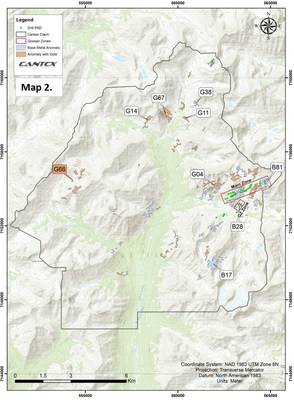Cantex Extends Strike of Main High Grade Massive Sulphide Zone and Provides Drilling Update for G66 High Grade Copper Anomaly on the North Rackla Project, Yukon
KELOWNA, BC, Sept. 13, 2021 /CNW/ - Cantex Mine Development Corp. (TSXV: CD) (the "Company") has released an update on the work program at its 100-percent-owned 14,077 hectare North Rackla claim block in the Yukon.
Dr. Charles Fipke reports:
Main Zone Drill Results
Since the news release of July 13, 2021, ten core holes have been completed from drill pads MZ36, MZ49A, MZ50A, MZ51 and MZ51A in the central and northeastern part of the Main Zone (refer to Map 1). Exceptionally strong lead-zinc massive sulphide intersections were encountered in nine of the ten holes drilled with strong copper mineralization present in seven of the nine holes. The mineralized intersections varied in apparent widths up to 11.3 metres. Drill confirmed mineralization extends 2.1km from the strongly mineralized Extension Target to Pad MZ51A. The mineralization is open to depth and along strike.
High Grade Copper – Anomaly G66
Two core holes, each at a -45 degree dip were drilled to test the area of surface rock sampling that analyzed up to 21.7% copper and 60 g/ton silver. Massive chalcopyrite (copper-rich sulphide) was intersected between 20.5 and 20.8 metres in the first core hole drilled at an azimuth of 261 degrees and moderate to strong chalcopyrite was intersected between 47 and 55.4 metres in the second hole drilled at an azimuth of 286 degrees. However, the actual target depth was about 90 metres to the zone of surficial high grade copper mineralization in rock/talus so it is believed that the zone of surficial high-grade copper has not yet been intersected. See Map 2 for the location of Anomaly G66.
Two possible explanations have been identified for the location of the mineralization.
First, structural geologist Chris Buchanan has indicated the high-grade surficial copper to be controlled by axial plane cleavage faults of a F1 syncline (synform). It is thus possible that the drill holes passed under the copper mineralization controlled by the syncline. A vertical hole at the site of the surficial high- grade copper would determine the thickness and grade of copper mineralization within the syncline and determine underlying bedding dips (valuable for structural interpretation).
Second, the zone of high-grade surficial rock/talus copper mineralization is not outcropping because it is covered by extensive talus and alpine glacial sediments. An alpine glacier has moved downslope in an east to west direction covering the north-south trending zone of mineralization in talus. It is thus possible that the high-grade copper mineralization in talus has been moved by the alpine glacier (and perhaps talus slides) from upper dolomitic units in the east, westward downslope to the present north-south trending area containing the high-grade copper mineralization in rock/talus.
Further work to be done consisting of soil-talus samples will be collected beginning at the highest topography in the east, down the slope of the alpine glacier westward to the high-grade surficial copper zone. The analytical results of these soil-talus samples for copper will determine whether there is a high-grade copper zone east of the present drill pad.
The drill rig will remain on site until it is determined whether it should be moved eastward or alternatively to the high-grade copper zone to test the possible synclinal thickness with a vertical hole.
The technical information and results reported here have been reviewed by Mr. Chad Ulansky P.Geol., a Qualified Person under National Instrument 43-101, who is responsible for the technical content of this release.
Signed,
Charles Fipke
Charles Fipke
Chairman
Neither TSX Venture Exchange nor its Regulation Services Provider (as that term is defined in the policies of the TSX Venture Exchange) accepts responsibility for the adequacy or accuracy of this release. Information set forth in this news release includes forward-looking statements under applicable securities laws. Forward-looking statements are statements that relate to future, not past, events. In this context, forward-looking statements often address expected future business and financial performance, and often contain words such as "anticipate", "believe", "plan", "estimate", "expect", and "intend", statements that an action or event "may", "might", "could", "should", or "will" be taken or occur, or other similar expressions. All statements, other than statements of historical fact, included herein are forward-looking statements. By their nature, forward-looking statements involve known and unknown risks, uncertainties and other factors which may cause the actual results, performance or achievements, or other future events, to be materially different from any future results, performance or achievements expressed or implied by such forward-looking statements. Such factors include, among others, risks identified in the management discussion and analysis section of the Company's interim and most recent annual financial statements or other reports and filings with Canadian securities regulators. Forward looking statements are made based on management's beliefs, estimates and opinions on the date that statements are made and the respective companies undertake no obligation to update forward-looking statements if these beliefs, estimates and opinions or other circumstances should change, except as required by applicable securities laws. Investors are cautioned against attributing undue certainty to forward-looking statements.
SOURCE Cantex Mine Development Corp.

![]() View original content to download multimedia: http://www.newswire.ca/en/releases/archive/September2021/13/c6320.html
View original content to download multimedia: http://www.newswire.ca/en/releases/archive/September2021/13/c6320.html

